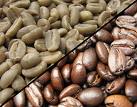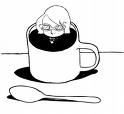The cupping process was conceived as a means for evaluating and comparing different coffees on a level playing field. Because the differences between great coffees can be very delicate, observations about the characteristics of those coffees (flavor, body, finish…) can be easily influenced by small variations that occur as part of most brewing methods. By eliminating some of these variables, a carefully prepared cupping allows the coffees being tasted to compete on the basis of their own intrinsic merits.
Some degree of scientific rigor is key to conducting a fair cupping. Measurements of water and coffee grounds should be precise, any grinding equipment should be flushed between cups to prevent cross-contamination, and the pouring of hot water should be done with great consistency. Time is also a factor; once the grounds are wet the steeping process is underway, and the coffee will undergo many changes in chemistry and flavor over the next 20 minutes.
It is very important to evaluate each coffee from the start of this cycle to the finish, so most cuppers have developed a protocol for managing this sequence of events to ensure that every coffee on the table gets equal treatment.
For casual cupping at home the protocols need not be so rigid, as the stakes are quite different. Cupping coffee at home can open you up to a whole new world of what makes coffee the special thing it is to many of us. You’ll discover flavors and nuances you never thought existed in a cuppa joe. You’ll learn to evaluate and categorize coffees that would do well in your own custom blends, if you’re a home roaster, or even if you’re buying a variety of single origin beans, and post blending them at home.
Cupping is also very much a social thing. While one can cup alone, cupping is best done in a group, where you can compare and contrast notes, opinions and thoughts on what you are sampling. For many beginning cuppers, evaluating coffee with others will open your eyes and your tastebuds to nuances in a coffee you might have otherwise missed - your cupping partners will point something out and you will revisit the sample and possibly discover it yourself.
A site for coffee nerdom, espresso foolery and what's happening in the cuppa. We hope to inform, educate, humiliate and offend most everyone that enjoys a good, honest and not so honest cup of coffee every morning, lunch and dinner
Email the Coffee Nerds at covertcoffee@gmail.com
Saturday, May 19, 2007
Cupping for Beginners - Why People Cup Coffee
Subscribe to:
Post Comments (Atom)







No comments:
Post a Comment